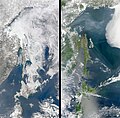File:Sea of Okhotsk Season Winter Summer 2008.jpg
Appearance

Size of this preview: 612 × 599 pixels. Other resolutions: 245 × 240 pixels | 490 × 480 pixels | 784 × 768 pixels | 1,046 × 1,024 pixels | 2,091 × 2,048 pixels | 6,256 × 6,126 pixels.
Original file (6,256 × 6,126 pixels, file size: 8.89 MB, MIME type: image/jpeg)
File history
Click on a date/time to view the file as it appeared at that time.
| Date/Time | Thumbnail | Dimensions | User | Comment | |
|---|---|---|---|---|---|
| current | 05:58, 26 April 2022 |  | 6,256 × 6,126 (8.89 MB) | Artanisen | Uploaded a work by Ocean Color Image Gallery. NASA. Accessed July 3, 2008. from The Earth Observatory - NASA - https://earthobservatory.nasa.gov/images/8893/shiretoko-peninsula with UploadWizard |
File usage
The following page uses this file:
Global file usage
The following other wikis use this file:
- Usage on ca.wikipedia.org
- Usage on ja.wikipedia.org
- Usage on sr.wikipedia.org


